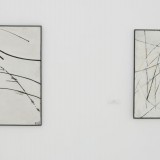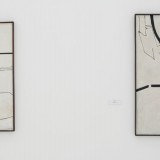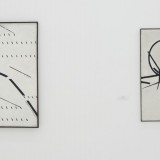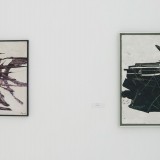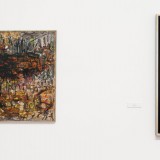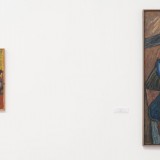Teresa Tyszkiewiczowa
Teresa Tyszkiewiczowa (born 1906 in Kraków ‒ died 1992 in Łódź) a painter who created works of art in the form of non-geometric abstraction. She was also a fabric designer and an illustrator of books and magazines for children (Świerszczyk among others).
She was a daughter of a Count Ignacy Ledóchowski and Countess Paulina Łubieńska, so among her friends she was called “Countess”. She studied between 1926-1933, first in the School of Artistic Industry in Kraków and from 1928 in the Fine Arts School in Warsaw, under the supervision of Felicjan Szczęsny Kowarski amongst others. After she married Stanisław Tyszkiewicz in 1933 she moved to Lelechówka close to Lwów, which then became a meeting point for the artistic and literary community (her guests were among others Leon Chwistek and Tytus Czyżewski). Her work from that period was shown during her first solo show in the Society for Fine Arts in Lwów in 1936. According to the preserved sources, they were modern works, which were recognised by the avant-garde milieu. Tyszkiewiczowa herself mentions that her first individual exhibition an exhibit in the Henryk Koterba Salon in Warsaw in 1937.
After the outbreak of the war, the Tyszkiewiczs left their estate and the Soviet occupation in 1940. They travelled to the General Gouvernment (a part of Poland under Nazi occupation) and then moved to Warsaw. After the war they moved to Łódź, where in 1946 Tyszkiewiczowa was hired by a newly founded Fine Arts College in Łódź, with which she was associated until she retired. Because of the obligatory socialist realism, she decided to quit the job in the painting studio. Instead she mastered the skills associated with fabric design and under the consent of the rector, she took up a position in the Department of Industrial Design, where she founded a Faculty of Print on Fabric.
In 1948 the artist participated in the 1st Exhibition of Modern Art in Kraków and in two subsequent “modern” exhibitions in Warsaw in 1957 and 1959. She also participated in exhibitions in the Krzywe Koło Gallery in Warsaw and Krzysztofory Gallery in Kraków. She also presented her paintings in group shows abroad: in Belgrade, Zagreb, Ljubljana and Berlin and presented her illustrations in Moscow, Vienna, Amsterdam and in Brussels amongst other places. She participated in general artistic life, at meetings in a reading club called Pickwick and within the art groups Piąte Koło and Nowa Linia in Łódź. Her friend Miron Białoszewski, wrote four poems under the common title “At Teresa Tyszkiewiczowa’s paintings”. Other friend included Józef Czapski, Tadeusz Kantor from the Kraków Group, and Maria Jarema. Also Stanisław Fijałkowski and Jerzy Nowosielski were friends of hers after she moved to Łódź.
Some of the artists’ works most probably were destroyed during the war. Others were destroyed by the artist herself, so her works from before the war are not known. In one of her statements Tyszkiewiczowa spoke about herself as a colourist and admitted that she painted “like Modigliani”. Her oldest known painting Flowers is dated 1938. In the forties Tyszkiewiczowa painted works inspired by cubism, for example Red Couch (1947), Football match (1948), Fight (1948), Composition (1949) and a sketch entitled People penguins (1945), in which the main topic is cubist deformation of a human figure.
According to the artist’s statement, cubism was a continuation of her interests and creative research from before the war. She wrote about her fascination with Picasso and his “cubist expressionism” which according to her corresponded with present times.
The fifties were for Tyszkiewiczowa the time of searching. Her painting was inspired then by tachism and the art of gesture which were current in the West. The abstract expressionism of Tyszkiewiczowa was based on accident, intuition and subconsciousness ans this was a starting point for the artist. In the creative process, after the spontaneous gesture of throwing paint at canvas, there followed the need for control and ordering of the composition. Unnecessary elements are eliminated by her through methods such as painting over or scratching away from the surface of the canvas. This allowed her to reach a harmony and a clean form, appropriate proportions and relations between forms. Her art is compared to writing and calligraphy. Abstract art according to Tyszkiewiczowa is supposed to express the existence of the non-material world and to evoke associations in order to give the possibility of interpretation of her paintings through signs and symbols. In the mature period of her work, in the second half of the sixties, the above mentioned methods of cleaning away unnecessary forms lead Tyszkiewiczowa to a characteristic type of a painting. It was also evident in her series entitled Dead ends continued in the seventies. These were rhythmical compositions, in black and white, in which she operated with a contrast of forms, for example with the opposition of an arc and circle, which was the main theme of composition in later paintings from the same cycle. In subsequent years, the art of Tyszkiewiczowa developed of issues dealing with a painterly gesture as a means of expression and structure of the painting.
Through her entire life, Tyszkiewiczowa made notes in the form of diaries, including her thoughts on art, readings and meetings. Notes from 1940-1983 were preserved, and they prove her broad interests (e.g. with philosophy, Buddhism, quantum physics) and the desire to follow everything which was modern.
Agata Mendrychowska


